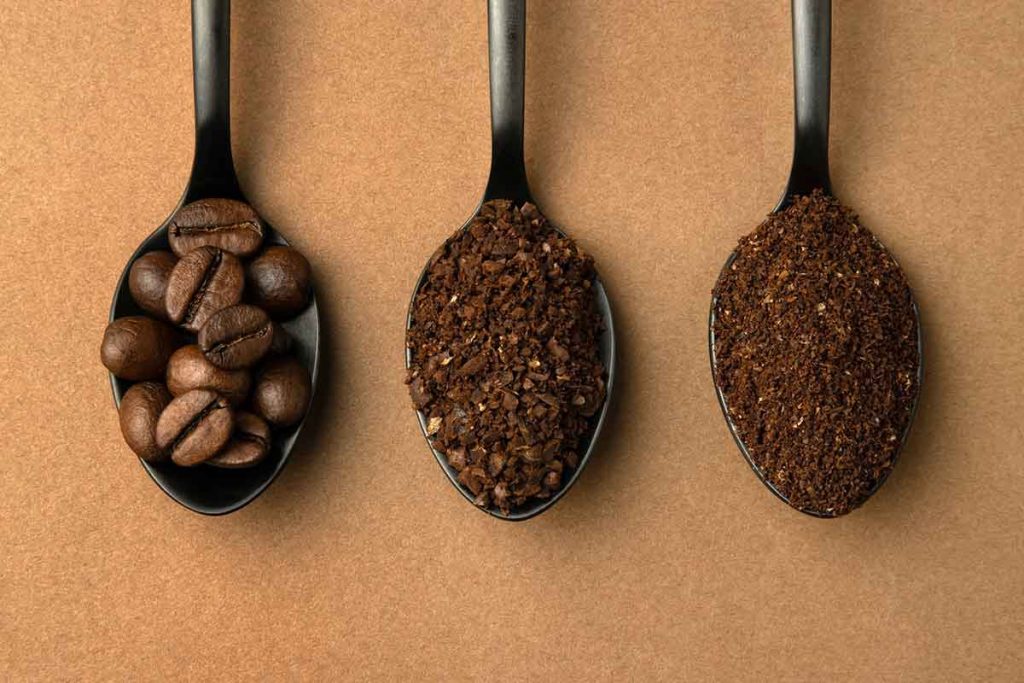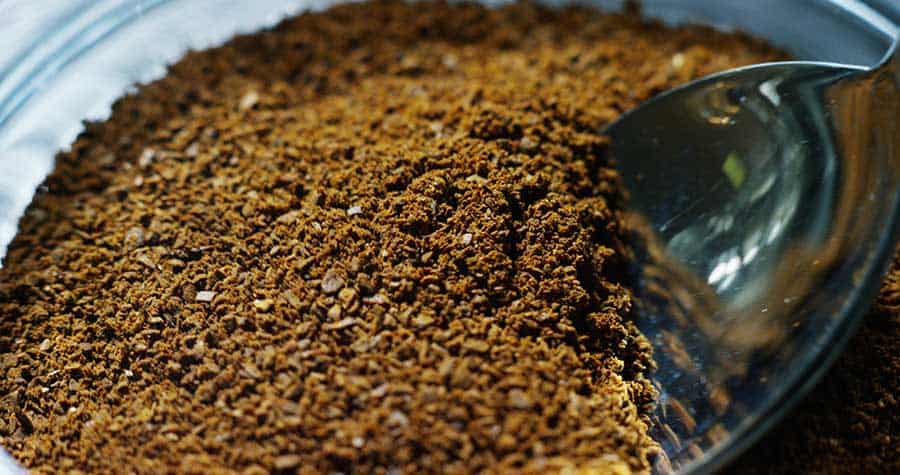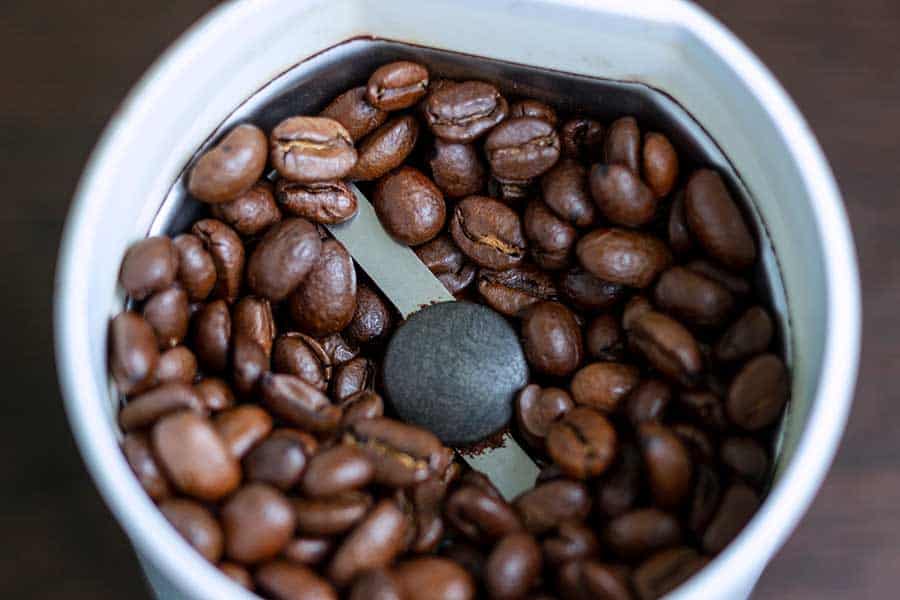Complete Coffee Grind Size Chart for All Brewing Methods

Mastering coffee grind sizes for different brew methods is an important milestone for anyone who loves good coffee. You can run from it for a while, but you can’t hide. Upsetting brewing outcomes will compel you to get this skill down pat.
It doesn’t matter how great your coffee maker or espresso machine is or how well you know the brewing techniques and steps. If you get the grind size wrong, the resulting brew will definitely be a disappointment.
This process may be tedious, and you may get discouraged at first, but you will get through it, and you will get to the point where you’ll know coffee grind sizes like the back of your hand. The coffee grind size chart that I’ve included below will help you!
First things first. Why is it important for you to know this?
Why the Right Grind Size Matters
The ultimate goal of choosing the correct grind size is to extract the right amount of flavor from the beans. Miss the size even a little bit and the next thing you will be dealing with is over-extraction or under-extraction.
Under-extraction is when you fail to extract enough flavor from the coffee. This will inevitably lead to a sour, salty acidic drink. Over-extraction is the opposite of that. You extract excess flavor from the grounds and this results in a cup that’s bitter, hollow, and far from delicious.
If you ever find yourself facing either of these scenarios, the major culprit is more than likely going to be the grind size. As you go about fixing the grinds, though, don’t forget you might need to adjust the brew time, water temperature, or coffee-to water-ratio as well. All of them play an equally important role in the brewing process.
Let’s now get to my grind size chart!
My Ultimate Coffee Grind Size Chart
There’s no one-size-fits-all grind size. You will notice that some sizes suit a specific brewing style while other sizes can be shared among multiple brewing methods. This is summarized in the chart below, but I’ll also walk you through the seven popular coffee grind sizes, explaining them in detail and pairing each to the brewing method(s) it’s suitable for.
[ninja_tables id=”4021″]
More About the Coffee Grind Sizes
Extra Coarse
This is the biggest size you can get from most grinders, often produced using the largest available setting. As a result, the beans may not lose their shape completely and the grounds will have a rough texture. The particles are about the same size as ground peppercorns.
One major attribute you should know about extra coarse grinds is that they take a long time to release all the flavor, a fact that makes them ideal for very slow brewing methods. You can use it for:
- Cold brew
- Cowboy coffee
Cowboy coffee is a traditional beverage where the coffee is heated with water and then served after the grounds have settled. These two have a slow extraction rate so anything less coarse than that would lead to over-extraction.
Coarse
A coarse grind resembles sea salt or kosher salt and needs more brewing time than an extra coarse grind. It’s the size preferred for coffee cupping because it locks in the beans’ flavor and aroma. It has a much-coveted richness.
Coffee cupping is a professional process where aromas are observed in brewed coffee. This application aside, a coarse grind fits the following brewing methods:
- French press
- Percolator
- Coffee cupping
Percolators use a higher brewing temperature than most of the other brewing methods so you will want to keep the grind size perfect because anything finer than that will lead to over-extraction.
Medium-Coarse
Just as the name says, this grind size falls in between medium and coarse. Its texture should be like that of rough sand. Extraction is still slow, but for most immersion and batch brewers this is the best size. Water flows more freely, allowing for optimal extraction within the recommended brew time.
Medium-coarse beans work best with brewers such as:
- Chemex
- Cafe solo
- Clever dripper
Medium
We are now in the middle of our list. A medium grind has the consistency of normal sand.
It is the safest grind size to experiment with because it has moderate extraction so you are less likely to face over-extraction or under-extraction, but there’s a catch: this grind isn’t as flavorful and rich as the other sizes. Granted, you will get a delicious cup of joe, but it will be average.
Brewing methods that work best with this size include:
- Drip coffee
- Siphon brewer
- Pour over (cone-shaped)
- Aeropress (brew for 2-3 minutes)
- Vacuum coffee maker
- Stovetop brewer
Medium-Fine
From the name, you can tell the texture of this grind. It is neither fine as sugar nor coarse as regular sand. For a beginner, this can be hard to achieve, but I would suggest that you aim for table salt texture. Make it a little bit smoother than regular sand.
Medium-fine ground coffee is suitable for the pour over method. The extraction rate is slightly faster than what you would experience with a medium grind. You can also use the same grind for other brewing methods such as vacuum and Aeropress brewers; however, you will have to adjust the brewing time to avoid instances of over-extraction or under-extraction.
Fine
Fine is one of the most popular grind sizes. It’s almost as smooth as powder or sugar. You are probably familiar with it because this is the size most pre-ground coffee beans for espresso come in.
Fine coffee grounds are suitable for brewing methods where water has very brief contact with the beans, meaning that the extraction rate is relatively fast. You should therefore use it with the following:
- Moka pot
- Espresso machine
- Aeropress (brew for 2 minutes)
Espresso machines and stovetop espresso makers produce pressure that forces water through finely-ground coffee, resulting in a rich flavorful shot. If the grind is more fine or coarse, your shot will taste different.
Extra-Fine
Extra-fine grinds are uncommon but still usable. To achieve an extra-fine grind that’s consistent, you will need a Turkish coffee grinder; commercial coffee grinders won’t hack it. The texture of such grounds is similar to that of flour.
Such a grind is suitable for:
- Turkish coffee
- Arab coffee
Coffee Grinder Size Numbers
Unfortunately, there are no fixed grind size numbers in my coffee grind size chart. Each grinder has its own unique settings that you have to understand before using it.

For most burr grinders, the numbers refer to the distance between the burrs. You will notice that the lowest number is recommended for espresso, which is the measurement that will give you the finest coffee grounds. As you move up, the grind becomes more coarse.
Take your time to know how the grind settings on your specific grinder work for the different brewing methods.
The manuals will always have the grind size numbers listed. If you haven’t bought a burr grinder yet, here are some trusted brands you will never go wrong with:
- Sage
- Cuisinart
- Baratza
- Porlex
- JavaPresse
- Hario
- Delonghi
Pre-Ground vs Whole Coffee Beans
There’s technically an easy route to getting the right grind size, which is to buy pre-ground beans from a coffee shop or store. You also won’t spend as much, but there’s a catch: ground coffee beans only hold their peak freshness for about 30 minutes.
Some flavors and aromas vanish after this period, denying you the chance to experience rich full-flavored coffee. The good news is you are not tied to this option.
Although they cost more than pre-ground coffee, whole coffee beans are the perfect alternative for many. No matter the roast, the beans come to their best flavors a few days after roasting, when they’ve had enough time to rest and degas, and they retain these flavors within a margin of 1 to 2 weeks.
Only grind them when you want to brew so as to keep all the flavors in your drink. And brew promptly after grinding. If you leave them unbrewed longer than 15 to 30 minutes after grinding, those flavors will start to disappear and this will cause your coffee to have a flat taste.
The other advantage of using whole coffee beans is that you can grind them to different sizes, depending on your brewing method. For that, you must choose the right grinder.
Choosing a Grinder
Not all coffee grinders will give you the perfect grind size; some are more capable than others. For today, I will tie you down to the most popular options that coffee connoisseurs use for grinding.
- Blade grinders
- Burr grinders
The blade vs burr grinder debate has been going on for years but it’s not difficult to tell the winner.
Blade Grinders
Of the two, blade grinders are the cheapest, and that’s mostly what draws people to them. They are also small, a fact that makes them more convenient for most people; however, they aren’t great at producing even grinds, and here’s why:
These grinders use metallic blades that move at high speeds (20,000 – 30,000 rpm) to crush the beans. Unfortunately, the process is messy and the grinds are very inconsistent. Some particles will be too coarse, others too fine, and this will cause uneven extraction, leading to unbalanced coffee.
In addition, they create too much heat which often burns the coffee, making it taste overcooked. Your beans could be fresh and well roasted but a blade grinder can still ruin the brewing process altogether.

Burr Grinders
Burr grinders are the holy grail of coffee grinding. They may be more expensive but they are almost perfect. Unlike blade grinders, they combine two burrs that apply uniform pressure in crushing the beans, creating a consistent grind as a result.
Another great thing about burr grinders is that they feature adjustable settings, giving you the freedom to grind your coffee beans to any size. This makes them the best option for the eager coffee user who wants to experiment with different brewing methods. Baristas love them too for this reason.
You will come across various designs, some more compact than others. Incredibly cheap models are available as well but don’t be swayed by price alone. Look at the other features to be sure that you are settling on an option that’s convenient and suitable for your brewing needs.
Familiarize yourself with coffee grind size number in your unit and figure out where each number setting falls in the chart.
Frequently Asked Questions
What is stronger: coarse or fine coffee?
There’s no straight answer to this question. The strength of your brew is determined by many things, but grind size isn’t “directly” involved. Both coarse and finely-ground coffee beans can make strong coffee (strong in this case meaning more caffeine content). It all depends on the extraction time and coffee-to-water ratio.
Finely ground coffee beans have a more exposed surface area. Extraction is usually fast, so for the shorter period they will be in contact with water, more caffeine and flavors will be released leading to a more concentrated drink.
A coarser grind, on the other hand, has very little surface area exposed and this creates a need for more contact time with water. The extraction rate is therefore slow but you can control brew strength by adjusting the brewing time and coffee-to-water ratio.
In fact, a cup of regular drip coffee could have more caffeine content than a shot of espresso. There may be slight variations in caffeine content among the different brewing methods, but the bottom line is that both coarse and finely ground coffee beans can give you strong coffee.
Are cheap coffee grinders worth it?
Blade grinders are typically cheaper than burr grinders, and I would say that the cheap blade grinders aren’t worth it for all of the reasons listed above.
Even in the burr grinder market, though, there are cheap and expensive models. It’s not an easy decision to choose between the two. Expensive doesn’t always translate to better and cheap doesn’t always mean not worth it.
Take your time to study the option you want to settle on. Examine the features, check the brand’s reputation, analyze the reviews, and then make an informed decision. It’s possible to find a relatively cheap burr grinder that does an excellent job.
Can you grind coffee beans in a blender or food processor?
Yes, it’s possible to use other tools such as blenders or food processors to grind coffee beans if, for one reason or the other, you do not have a grinder.
Some blenders, in fact, feature a “grind” setting. The consistency may not be as great as that of a burr grinder, but the grounds will do the job. If you use this method, do it in short, quick bursts. The blades in a blender heat up fast due to the high rotating speeds, so if you do not take breaks you may end up burning the coffee beans.
Food processors can also grind your coffee beans to a size that’s best for brewing. Just like blenders, they don’t produce the evenest grinds. The blades also get hot fast, so you have to make short stops to avoid destroying your coffee beans.
Final Word on Coffee Grind Sizes
In your life as a coffee user, this is probably the most important subject you will ever learn. You may print or take a screenshot of this coffee grind size chart so you can refer to it when you encounter an unfamiliar brew method.
Even if you only make coffee using one method, it is important that you understand how the different grind sizes affect your brew.
It’s not enough to only know about the grind sizes. Since we have already established that freshly roasted beans are the best option, go the extra mile and find out which brands and suppliers are reliable.
Do the same for coffee grinders. Step into the market and thoroughly search for an option that best suits your brewing needs.
Happy brewing!
Owen is a writer and editor at Caffe Streets who considers himself a coffee fanatic. He spends his time researching and testing different coffee beans and brewing methods and sharing what he learns with others.





